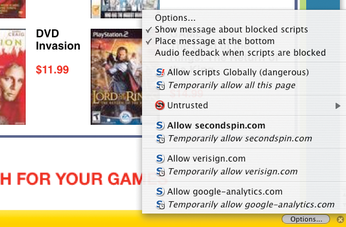Protecting your site and your clients
Web Security

Learn more about protecting your website with NoScript, ModSecurity, and Site Security Policy.
Like many security issues, the World Wide Web presents two very different sets of problems with some very different solutions. On the one side, most of us use a web browser on a regular basis and want to prevent our web clients from running an attacker's code, letting them take over our machine. On the other side are web servers, which you don't want to see compromised, under constant attack (XSS, SQL injection, etc.). So what's the answer? Well, there is no single answer. You need to take steps to protect both the clients and the servers because no matter how security conscious you are, you will interact with servers or clients that are less secure.
JavaScript and NoScript
For the Firefox web browser, out of 196 security advisories, 62 listed disabling JavaScript as a workaround. Additionally, the JavaScript-based vulnerabilities tend to be the ones that allow for arbitrary code execution, so any preemptive security measure that deals with them will have a significant effect.
Securing web clients against attacks is relatively simple; however, some websites might not work properly. Disabling JavaScript entirely is one option, but many sites now rely on JavaScript to present content, forms, and so on.
A more fine-grained approach is available with the NoScript plugin for Firefox [1]. The default is to block JavaScript execution, and then you can choose to allow JavaScript to run temporarily or permanently. Or, you can permanently mark a site as untrusted to prevent any JavaScript from ever being executed from that site (Figure 1).
The major downside to this plugin is that you need to pay attention to the information bar that pops up at the bottom of the screen when JavaScript is blocked (Figure 2) and decide whether or not to allow it. If you don't, you will find yourself, as I have, staring at a website wondering why it is mostly blank, or why an online form isn't working properly.
Additionally, NoScript has some basic cross-site scripting protection – URLs with characters such as ">" in them will generate a warning and give the user a chance to block their loading.
Securing the Server
As a server admin, you can't force clients to be secure, but you can protect your own server and web-based applications from attack. Protecting your server can also prevent broken clients or users who have visited hostile sites from taking actions that might harm their accounts or the data hosted on your site – for example, from a cross-site scripting attack that interacts with the user's account to change the password on their account at your site.
Apache ModSecurity
Like many security projects, ModSecurity started out as an open source project, licensed under the GPL v2 and aimed at adding a layer of security to the Apache web server [2]. The project appears to have been commercialized successfully; however, like many open source security applications, free versions are still available.
The main benefit of ModSecurity is that you can use it to provide security for any application running on your system. On the downside, you must be able to insert a custom module into Apache – meaning you need to have control over the server – and have enough CPU power to handle the additional processing required by this module, which can be significant. The ModSecurity module allows requests to the server to be examined at various stages in the process: when the request header is first processed, when the request body is processed, when the response headers are created, when the response body is processed, and at the logging phase.
Another advantage of ModSecurity is that it supports Perl-Compatible Regular Expressions (PCRE), and the rules it supports can also trigger a variety of actions, including to allow or block a request, to drop the connection by sending a FIN packet, or to execute an external program. For example, this allows site admins to filter out characters such as "<" and ">" from requests – a likely indicator of a cross-site scripting attack – or to look for personal information such as 12-digit credit card number strings within outgoing requests (e.g., triggered by an SQL injection attack) and block that data from being served to the attacker. See the "Example Rule" box.
As you can imagine, all this power and flexibility comes at the cost of complexity; however, this is alleviated because a powerful default rule set has been made available for free (licensed under the GPL v2), which can be used as a starting point for most sites.
Example Rule
A simplistic example to detect and block any 12-digit number in outgoing web pages:
SecRule RESPONSE_BODY "[0-9]{12}" \ "phase:4,t:none,ctl:auditLogParts=+E,deny,log,auditlog,status:500,msg:'a 12 digit number',id:'1',tag:'LEAKAGE/ERRORS',severity:'1'"
Buy this article as PDF
(incl. VAT)
Buy Linux Magazine
Subscribe to our Linux Newsletters
Find Linux and Open Source Jobs
Subscribe to our ADMIN Newsletters
Support Our Work
Linux Magazine content is made possible with support from readers like you. Please consider contributing when you’ve found an article to be beneficial.

News
-
Systemd Fixes Bug While Facing New Challenger in GNU Shepherd
The systemd developers have fixed a really nasty bug amid the release of the new GNU Shepherd init system.
-
AlmaLinux 10.0 Beta Released
The AlmaLinux OS Foundation has announced the availability of AlmaLinux 10.0 Beta ("Purple Lion") for all supported devices with significant changes.
-
Gnome 47.2 Now Available
Gnome 47.2 is now available for general use but don't expect much in the way of newness, as this is all about improvements and bug fixes.
-
Latest Cinnamon Desktop Releases with a Bold New Look
Just in time for the holidays, the developer of the Cinnamon desktop has shipped a new release to help spice up your eggnog with new features and a new look.
-
Armbian 24.11 Released with Expanded Hardware Support
If you've been waiting for Armbian to support OrangePi 5 Max and Radxa ROCK 5B+, the wait is over.
-
SUSE Renames Several Products for Better Name Recognition
SUSE has been a very powerful player in the European market, but it knows it must branch out to gain serious traction. Will a name change do the trick?
-
ESET Discovers New Linux Malware
WolfsBane is an all-in-one malware that has hit the Linux operating system and includes a dropper, a launcher, and a backdoor.
-
New Linux Kernel Patch Allows Forcing a CPU Mitigation
Even when CPU mitigations can consume precious CPU cycles, it might not be a bad idea to allow users to enable them, even if your machine isn't vulnerable.
-
Red Hat Enterprise Linux 9.5 Released
Notify your friends, loved ones, and colleagues that the latest version of RHEL is available with plenty of enhancements.
-
Linux Sees Massive Performance Increase from a Single Line of Code
With one line of code, Intel was able to increase the performance of the Linux kernel by 4,000 percent.



